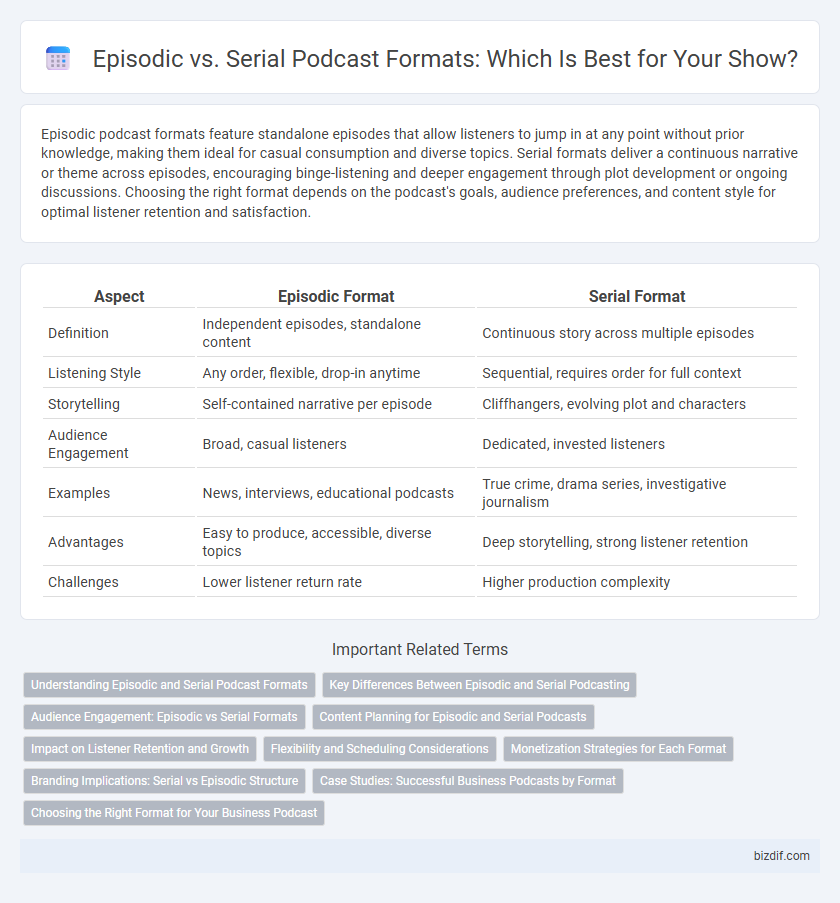Episodic podcast formats feature standalone episodes that allow listeners to jump in at any point without prior knowledge, making them ideal for casual consumption and diverse topics. Serial formats deliver a continuous narrative or theme across episodes, encouraging binge-listening and deeper engagement through plot development or ongoing discussions. Choosing the right format depends on the podcast's goals, audience preferences, and content style for optimal listener retention and satisfaction.
Table of Comparison
| Aspect | Episodic Format | Serial Format |
|---|---|---|
| Definition | Independent episodes, standalone content | Continuous story across multiple episodes |
| Listening Style | Any order, flexible, drop-in anytime | Sequential, requires order for full context |
| Storytelling | Self-contained narrative per episode | Cliffhangers, evolving plot and characters |
| Audience Engagement | Broad, casual listeners | Dedicated, invested listeners |
| Examples | News, interviews, educational podcasts | True crime, drama series, investigative journalism |
| Advantages | Easy to produce, accessible, diverse topics | Deep storytelling, strong listener retention |
| Challenges | Lower listener return rate | Higher production complexity |
Understanding Episodic and Serial Podcast Formats
Episodic podcast formats present standalone episodes that focus on unique topics, allowing listeners to jump in at any point without prior knowledge. Serial podcast formats follow a continuous storyline across episodes, building suspense and encouraging sequential listening to fully grasp the narrative. Understanding these formats helps podcasters tailor content to audience preferences and enhances engagement through structured storytelling or flexible topic exploration.
Key Differences Between Episodic and Serial Podcasting
Episodic podcasting features standalone episodes that allow listeners to access content in any order without losing context, making it ideal for topics like interviews or news updates. Serial podcasting follows a continuous narrative with interconnected episodes, requiring listeners to follow sequentially for full comprehension, commonly used in storytelling or investigative journalism. The main difference lies in content structure and listener engagement, where episodic formats prioritize flexibility and serial formats emphasize narrative development.
Audience Engagement: Episodic vs Serial Formats
Episodic podcast formats foster audience engagement through standalone episodes that allow listeners to drop in at any point without prior knowledge, maintaining casual and flexible listening habits. Serial formats create deeper emotional investment by unfolding narratives or themes across episodes, compelling audiences to follow sequentially and anticipate future installments. Both formats leverage distinct engagement strategies: episodic for broad accessibility and serial for sustained listener loyalty and binge consumption.
Content Planning for Episodic and Serial Podcasts
Episodic podcasts feature self-contained episodes that allow listeners to jump in at any point, requiring content planning focused on standalone topics and consistent themes. Serial podcasts demand a narrative arc with carefully structured episode progression, where each installment builds on the last to maintain audience engagement and continuity. Effective content planning for serial podcasts involves detailed outlining and timing to ensure coherent storytelling and pacing throughout the series.
Impact on Listener Retention and Growth
Episodic podcast formats, offering standalone episodes, enhance listener accessibility and attract casual audiences, driving consistent growth through easy entry points. Serial podcast formats, with interconnected narratives, deepen listener engagement and loyalty by encouraging binge listening and sustained retention over time. Balancing episodic accessibility with serial storytelling depth maximizes audience expansion and long-term retention in podcast growth strategies.
Flexibility and Scheduling Considerations
Episodic podcast formats offer greater flexibility, allowing listeners to consume episodes independently without following a strict order, which suits casual listening and varied content topics. In contrast, serial formats require a sequential listening schedule as episodes build on previous content, demanding consistent release timing to maintain audience engagement and narrative continuity. Podcasters must weigh the scheduling ease and production demands of episodic formats against the immersive storytelling potential and listener commitment driven by serial formats.
Monetization Strategies for Each Format
Episodic podcast formats attract consistent listener engagement by offering standalone episodes that facilitate diverse sponsorship deals and dynamic ad placements, maximizing revenue through varied advertiser partnerships. Serial formats, with their continuous storytelling, create heightened listener loyalty and subscription opportunities, enabling monetization via premium content, exclusive episodes, and crowdfunding campaigns. Understanding audience consumption patterns in each format is crucial for optimizing targeted advertising and developing sustainable income streams.
Branding Implications: Serial vs Episodic Structure
Serial podcast formats encourage strong brand loyalty by creating continuous story arcs that keep listeners engaged over time, fostering a deeper emotional connection. Episodic formats offer greater flexibility and accessibility, allowing new audiences to discover and engage with individual episodes without prior knowledge, which can broaden brand reach. Choosing between serial or episodic structures impacts branding strategies by influencing audience retention, discoverability, and overall show identity in competitive podcast markets.
Case Studies: Successful Business Podcasts by Format
Case studies reveal that episodic podcast formats, such as "The Tim Ferriss Show," succeed by attracting diverse audiences through standalone episodes offering actionable insights. Serial formats like "How I Built This" engage listeners with narrative-driven storytelling, fostering deep emotional connections and sustained subscriber growth. Business podcasts using either format demonstrate that content consistency and audience alignment are critical factors for success.
Choosing the Right Format for Your Business Podcast
Selecting the right podcast format directly impacts audience engagement and brand alignment in your business strategy. Episodic formats offer standalone content that appeals to casual listeners and facilitate easier content discovery, while serial formats provide a continuous narrative ideal for building loyal, long-term listeners and deeper connections. Analyzing your target audience's listening habits and business goals helps determine whether episodic variety or serial storytelling best supports your marketing objectives.
Episodic Format vs Serial Format Infographic

 bizdif.com
bizdif.com